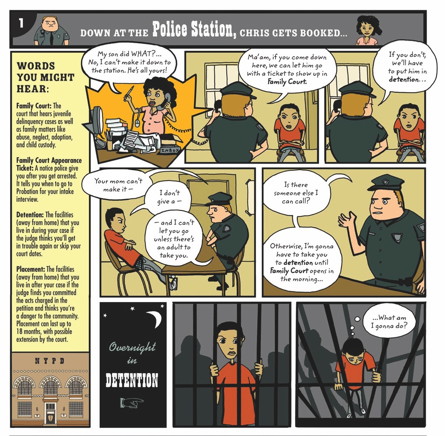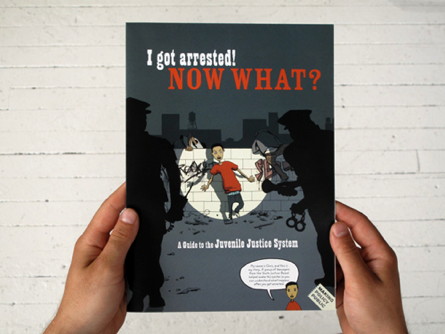
Image from "I Got Arrested" courtesy of the artist, Danica Novgorodoff, and the Center for Urban Pedagogy.
NEW YORK — He struggled to make sense of what the probation officer was talking about.
It had something to do with his upcoming court appearance, but after a night in jail and with his mother beside him, he was having trouble focusing on the man's words.
“It wasn’t fun. I was hungry. I was impatient and angry," said the teen, who was 14 at the time of his arrest on a misdemeanor. "I wanted to be outside with my family, that’s all I could think about."
Then the officer gave the teenager a comic about a boy who, like him, had gotten in trouble with the law.
Flipping through the pages, the teen read about how the boy spent a night locked up, like him, and had met with a lawyer, too. The boy in the comic also got sent to probation.
"It helped me understand," said the teen who is now 18 and asked to be identified by his initials, S.N.J., because he had been a juvenile during his arrest. "The same thing happened to me."
The comic book was produced by the Center for Urban Pedagogy, a Brooklyn-based nonprofit that works with artists and designers to help the city's diverse population understand, through visual aids, how government works.
Its latest project, Public Access Design, aims to give community organizations and advocacy groups the opportunity to use visual tools to address social justice issues as soon as they arise.
Proposals are due August 6, and will be considered in December, as well as in February, April and June 2013.
"We use visual communication to improve civic engagement, especially when certain people are excluded from city planning conversations," said Clara Amenyo, a program manager at CUP.
To create the comic that tells the story of how the criminal justice system works, in 2010 CUP teamed with a graphic novelist, the Department of Probation and youth leaders from the Center for Court Innovation. Their goal was to offer clear, engaging instructions for teens that have recently been arrested.
Ryan Dodge, a spokesman for the DOP, said when a teen is arrested and enters the probation office he or she is handed the comic.

“Oftentimes they don’t know what they are in store for. The comic gives a one-on-one overview in an understandable and accessible form,” he said.
Joshua Pacheco, a youth leader for CCI, said young people need more information when they get arrested. “The comic book is the solution,” he said.
For the Brooklyn-based designer of “I Got Arrested," Danica Novgorodoff, dealing with the unfamiliar terminology of the criminal justice system was one of the challenges. But she said each page has a vocabulary box explaining terminology in a simple way for teenagers.
“I think that graphic novels are a great way to explore material that can otherwise be overly dense or dry," she said.
For the center's latest project, six organizations will be chosen over the course of the year. The issues can range from breaking down a specific policy or organizing a particular cause. Projects will be chosen by a panel of artists and community advocates.
The end result of the project will be an “organizing tool” — either a printed book of images, a web interactive, animated video or a pocket-sized graphic.
CUP will support the entire research and design process and provide 1,000 copies of the print materials to the organization to distribute directly to those who need it. The project is funded through a grant from the Rockefeller Foundation's NYC Cultural Innovation Fund.
Amenyo said this project is different from previous initiatives because of its shorter development time and a smaller scope.
Typically, she said CUP's posters are made over six to eight months. The new project will take just three to four months, allowing community groups to respond immediately to social justice issues as they arise.
The idea for this latest project came out of working alongside advocacy groups. In the past, the group has worked with the Brennan Center for Justice to create a colorful guide on redistricting and with the Urban Justice Center's street vendor project on a manual that explains city regulations.
Matthew Shapiro, staff attorney with the street vendor project, said the manual helps vendors understand complicated regulations that can be difficult to understand, particularly for vendors with limited English skills. The manual is available in multiple languages, including English, Spanish, Bengali and Chinese.
“The manual has been a great guide for vendors,” Shapiro said, adding that it is sometimes used to clear up confusion with police officers who ask questions about vendors' activities. "Many times vendors show the police the manual.”




